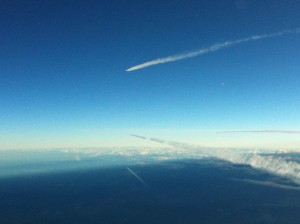The Big Sky
Where would we be without the Traffic Collision Avoidance System?
On a recent flight I was looking at my TCAS display and wondering how we ever did without this wonderful bit of equipment. TCAS stands for Traffic Collision Avoidance System, and I saw my first one in the early 90s. Prior to TCAS we had a three-prong approach to traffic avoidance: Air Traffic Control, "see and avoid," and the Big Sky theory.
"See and Avoid" has always been the time-honored technique when flying under visual conditions. "Keep your head on a swivel" is the phrase I used to hear from my primary flight instructor. "It's the one you don't see that'll kill you." In the airline world we don't worry too much about see and avoid when we're cruising, because we're in Positive Control Airspace and everyone up there (above 18,000 feet in the U.S.) is on an IFR (Instrument Flight Rules) flight plan and has an altitude reporting transponder. But when we're down low in the approach and landing phase of the flight, we're keeping a sharp lookout.
The last line of defense against mid-airs has always been the Big Sky theory. With so much airspace and so few planes, the chances of two of them colliding is a statistical improbability. But it happened in 1956, when a United flight and a TWA flight collided over the Grand Canyon and, of course, we've got a lot more planes in the skies these days.
It's hard to believe, but when TCAS was first introduced there was resistance among pilots. I think they saw it as a first step to having control taken from the cockpit. But that's the not the case at all. It's like having someone with eagle eyes in the cockpit keeping a constant lookout...and it works even in the clouds! Pilots quickly got so used to having TCAS, and so appreciated what it does for safety, that they became reluctant to fly if the TCAS unit wasn't working.
There are several different kinds of TCAS displays. They all show traffic within 40 miles of our plane and within 2,700 feet of our altitude (those limits can be increased to 8,700 feet if we want).
Here's a picture from a recent flight, showing two planes. The nearer one is 1,500 feet above us and climbing (indicated by the up arrow) and the farther one (almost off the display, which is set at 20 miles for this shot) is 1,600 feet below us.

The same two planes are visible in a view from the cockpit in the next picture only because they have contrails. (A third contrail can be seen, but that plane is not shown on the screen, either because it's more than 20 miles away or more than 2,700 feet below us.) Neither of these planes represents a threat at this point, but it's nice to know that TCAS keeps us aware of nearby traffic.

It would be hard to think of any other single bit of aviation technology that has increased safety so dramatically.
"See and Avoid" has always been the time-honored technique when flying under visual conditions. "Keep your head on a swivel" is the phrase I used to hear from my primary flight instructor. "It's the one you don't see that'll kill you." In the airline world we don't worry too much about see and avoid when we're cruising, because we're in Positive Control Airspace and everyone up there (above 18,000 feet in the U.S.) is on an IFR (Instrument Flight Rules) flight plan and has an altitude reporting transponder. But when we're down low in the approach and landing phase of the flight, we're keeping a sharp lookout.
The last line of defense against mid-airs has always been the Big Sky theory. With so much airspace and so few planes, the chances of two of them colliding is a statistical improbability. But it happened in 1956, when a United flight and a TWA flight collided over the Grand Canyon and, of course, we've got a lot more planes in the skies these days.
It's hard to believe, but when TCAS was first introduced there was resistance among pilots. I think they saw it as a first step to having control taken from the cockpit. But that's the not the case at all. It's like having someone with eagle eyes in the cockpit keeping a constant lookout...and it works even in the clouds! Pilots quickly got so used to having TCAS, and so appreciated what it does for safety, that they became reluctant to fly if the TCAS unit wasn't working.
There are several different kinds of TCAS displays. They all show traffic within 40 miles of our plane and within 2,700 feet of our altitude (those limits can be increased to 8,700 feet if we want).
Here's a picture from a recent flight, showing two planes. The nearer one is 1,500 feet above us and climbing (indicated by the up arrow) and the farther one (almost off the display, which is set at 20 miles for this shot) is 1,600 feet below us.

The same two planes are visible in a view from the cockpit in the next picture only because they have contrails. (A third contrail can be seen, but that plane is not shown on the screen, either because it's more than 20 miles away or more than 2,700 feet below us.) Neither of these planes represents a threat at this point, but it's nice to know that TCAS keeps us aware of nearby traffic.

It would be hard to think of any other single bit of aviation technology that has increased safety so dramatically.
/https://tf-cmsv2-smithsonianmag-media.s3.amazonaws.com/accounts/headshot/Steve-Satre-headshot.jpg)
/https://tf-cmsv2-smithsonianmag-media.s3.amazonaws.com/accounts/headshot/Steve-Satre-headshot.jpg)